Literature Review: Sustainable Restaurants in the Australian Market
VerifiedAdded on 2021/04/21
|9
|2308
|316
Literature Review
AI Summary
This literature review delves into the sustainable restaurant industry, focusing on key concepts like sustainable restaurants, vertical farming, and veganism, with a specific emphasis on the Australian market. The paper defines core terms, reviews relevant theories, and analyzes past studies to identify research gaps. It explores the growing market for organic and vegan food, highlighting market research and trends indicating a promising future for sustainable restaurants. The review examines the opportunities presented by vertical farming, including cost reduction and self-reliance, as well as the associated risks. It also discusses the opportunities and risks facing the sustainable restaurant industry, such as the increasing consumer demand for vegan food and the importance of credibility. The paper concludes by emphasizing the potential of sustainable restaurants as a transformative approach to food production, resource conservation, and utilization of local resources.
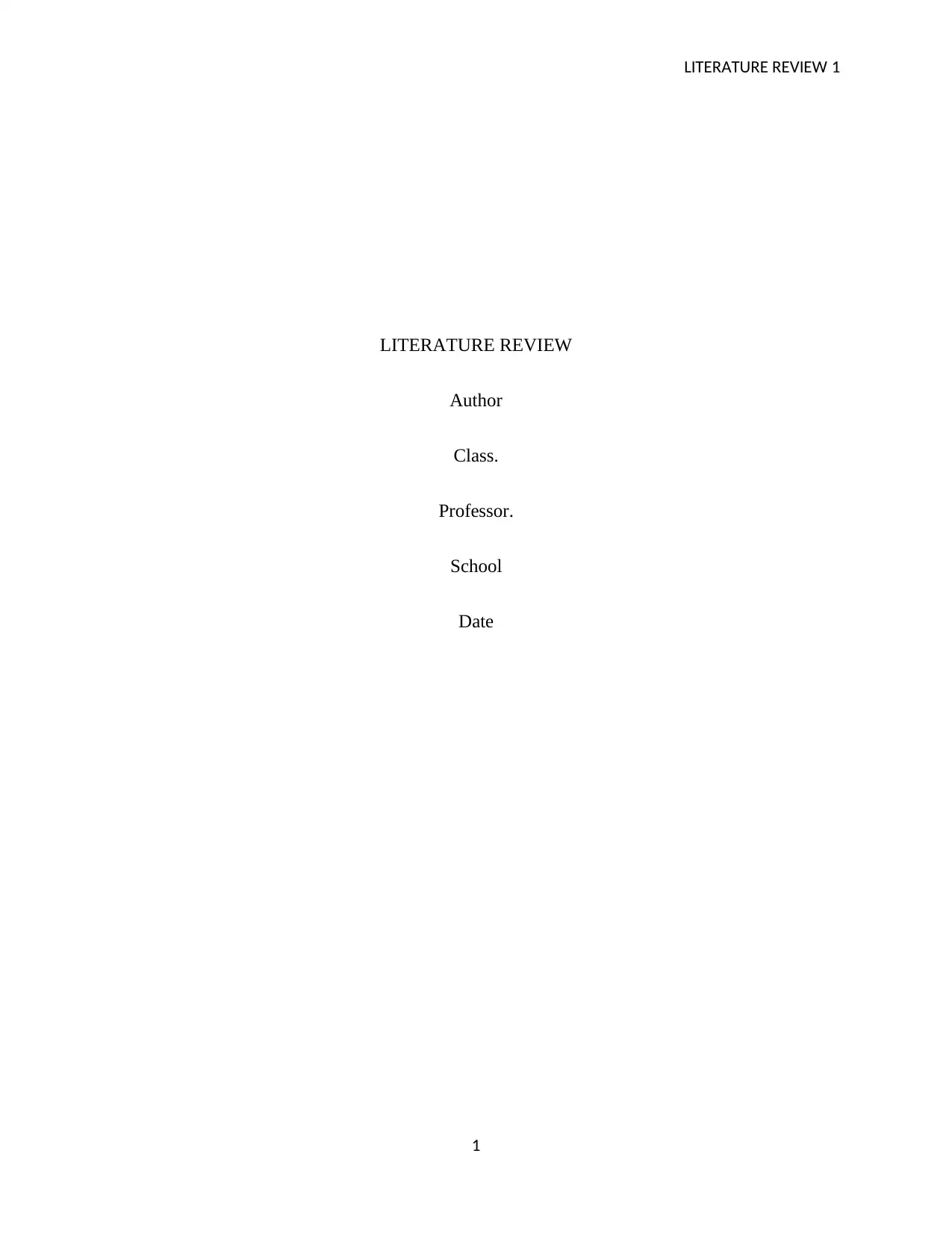
LITERATURE REVIEW 1
LITERATURE REVIEW
Author
Class.
Professor.
School
Date
1
LITERATURE REVIEW
Author
Class.
Professor.
School
Date
1
Paraphrase This Document
Need a fresh take? Get an instant paraphrase of this document with our AI Paraphraser
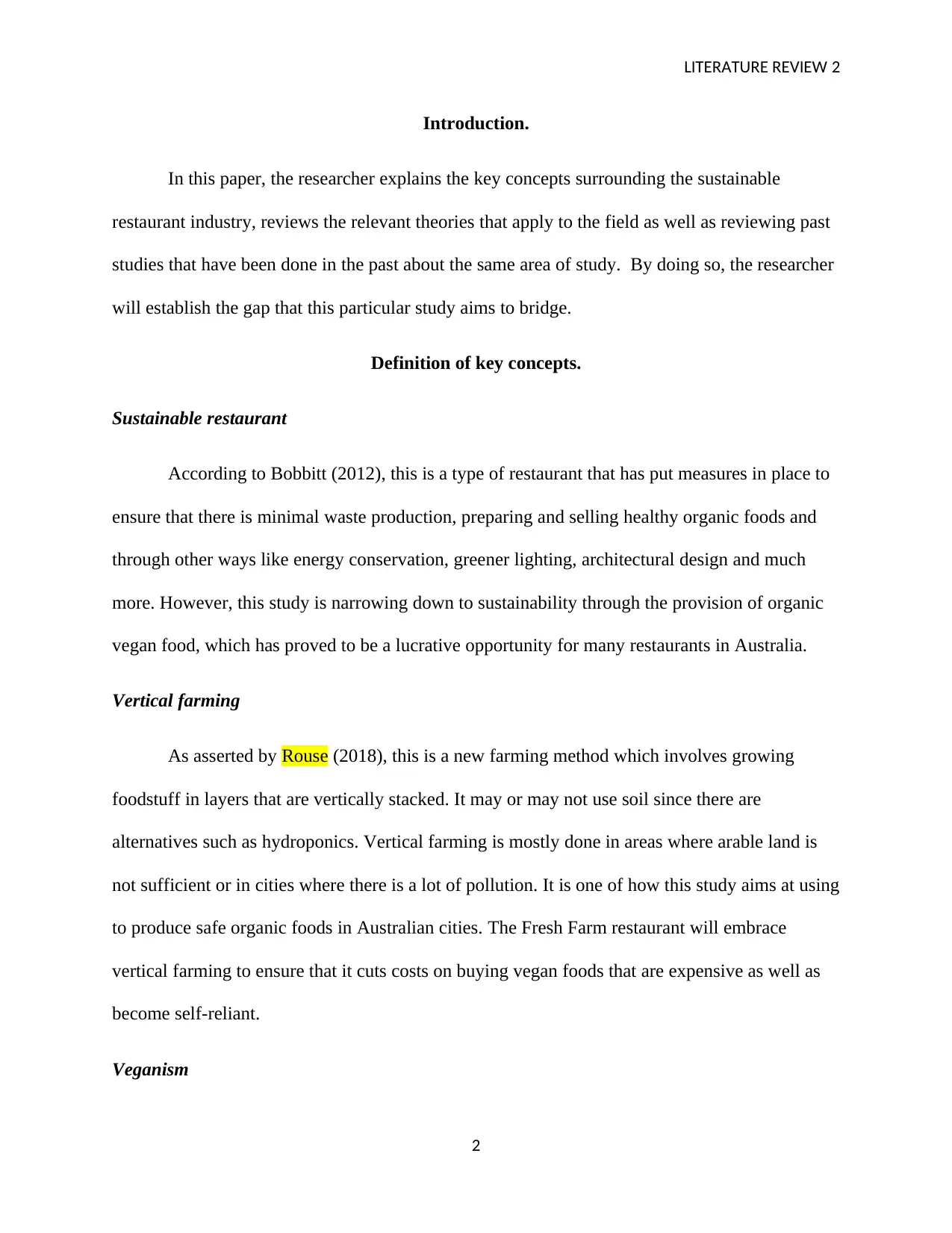
LITERATURE REVIEW 2
Introduction.
In this paper, the researcher explains the key concepts surrounding the sustainable
restaurant industry, reviews the relevant theories that apply to the field as well as reviewing past
studies that have been done in the past about the same area of study. By doing so, the researcher
will establish the gap that this particular study aims to bridge.
Definition of key concepts.
Sustainable restaurant
According to Bobbitt (2012), this is a type of restaurant that has put measures in place to
ensure that there is minimal waste production, preparing and selling healthy organic foods and
through other ways like energy conservation, greener lighting, architectural design and much
more. However, this study is narrowing down to sustainability through the provision of organic
vegan food, which has proved to be a lucrative opportunity for many restaurants in Australia.
Vertical farming
As asserted by Rouse (2018), this is a new farming method which involves growing
foodstuff in layers that are vertically stacked. It may or may not use soil since there are
alternatives such as hydroponics. Vertical farming is mostly done in areas where arable land is
not sufficient or in cities where there is a lot of pollution. It is one of how this study aims at using
to produce safe organic foods in Australian cities. The Fresh Farm restaurant will embrace
vertical farming to ensure that it cuts costs on buying vegan foods that are expensive as well as
become self-reliant.
Veganism
2
Introduction.
In this paper, the researcher explains the key concepts surrounding the sustainable
restaurant industry, reviews the relevant theories that apply to the field as well as reviewing past
studies that have been done in the past about the same area of study. By doing so, the researcher
will establish the gap that this particular study aims to bridge.
Definition of key concepts.
Sustainable restaurant
According to Bobbitt (2012), this is a type of restaurant that has put measures in place to
ensure that there is minimal waste production, preparing and selling healthy organic foods and
through other ways like energy conservation, greener lighting, architectural design and much
more. However, this study is narrowing down to sustainability through the provision of organic
vegan food, which has proved to be a lucrative opportunity for many restaurants in Australia.
Vertical farming
As asserted by Rouse (2018), this is a new farming method which involves growing
foodstuff in layers that are vertically stacked. It may or may not use soil since there are
alternatives such as hydroponics. Vertical farming is mostly done in areas where arable land is
not sufficient or in cities where there is a lot of pollution. It is one of how this study aims at using
to produce safe organic foods in Australian cities. The Fresh Farm restaurant will embrace
vertical farming to ensure that it cuts costs on buying vegan foods that are expensive as well as
become self-reliant.
Veganism
2
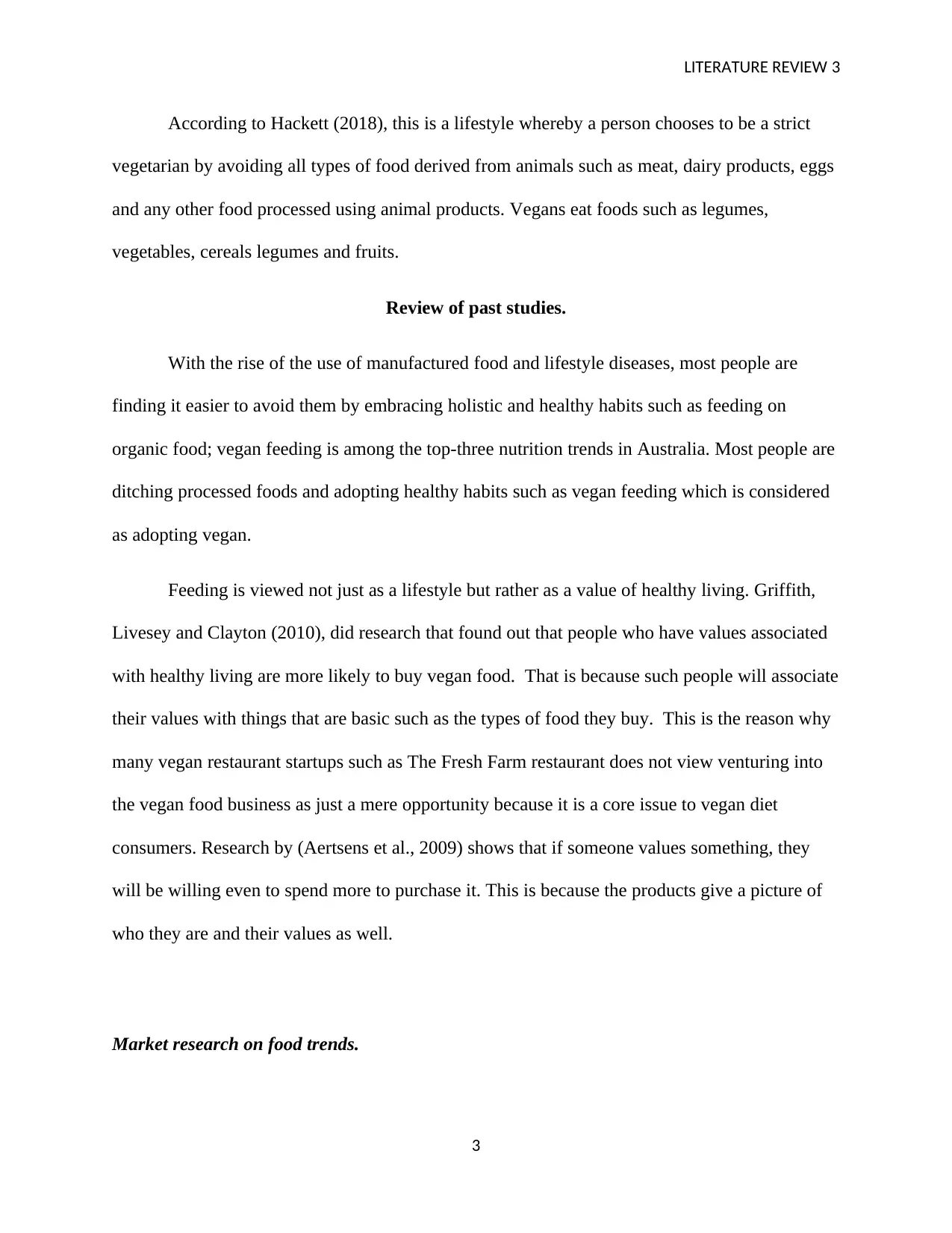
LITERATURE REVIEW 3
According to Hackett (2018), this is a lifestyle whereby a person chooses to be a strict
vegetarian by avoiding all types of food derived from animals such as meat, dairy products, eggs
and any other food processed using animal products. Vegans eat foods such as legumes,
vegetables, cereals legumes and fruits.
Review of past studies.
With the rise of the use of manufactured food and lifestyle diseases, most people are
finding it easier to avoid them by embracing holistic and healthy habits such as feeding on
organic food; vegan feeding is among the top-three nutrition trends in Australia. Most people are
ditching processed foods and adopting healthy habits such as vegan feeding which is considered
as adopting vegan.
Feeding is viewed not just as a lifestyle but rather as a value of healthy living. Griffith,
Livesey and Clayton (2010), did research that found out that people who have values associated
with healthy living are more likely to buy vegan food. That is because such people will associate
their values with things that are basic such as the types of food they buy. This is the reason why
many vegan restaurant startups such as The Fresh Farm restaurant does not view venturing into
the vegan food business as just a mere opportunity because it is a core issue to vegan diet
consumers. Research by (Aertsens et al., 2009) shows that if someone values something, they
will be willing even to spend more to purchase it. This is because the products give a picture of
who they are and their values as well.
Market research on food trends.
3
According to Hackett (2018), this is a lifestyle whereby a person chooses to be a strict
vegetarian by avoiding all types of food derived from animals such as meat, dairy products, eggs
and any other food processed using animal products. Vegans eat foods such as legumes,
vegetables, cereals legumes and fruits.
Review of past studies.
With the rise of the use of manufactured food and lifestyle diseases, most people are
finding it easier to avoid them by embracing holistic and healthy habits such as feeding on
organic food; vegan feeding is among the top-three nutrition trends in Australia. Most people are
ditching processed foods and adopting healthy habits such as vegan feeding which is considered
as adopting vegan.
Feeding is viewed not just as a lifestyle but rather as a value of healthy living. Griffith,
Livesey and Clayton (2010), did research that found out that people who have values associated
with healthy living are more likely to buy vegan food. That is because such people will associate
their values with things that are basic such as the types of food they buy. This is the reason why
many vegan restaurant startups such as The Fresh Farm restaurant does not view venturing into
the vegan food business as just a mere opportunity because it is a core issue to vegan diet
consumers. Research by (Aertsens et al., 2009) shows that if someone values something, they
will be willing even to spend more to purchase it. This is because the products give a picture of
who they are and their values as well.
Market research on food trends.
3
⊘ This is a preview!⊘
Do you want full access?
Subscribe today to unlock all pages.

Trusted by 1+ million students worldwide
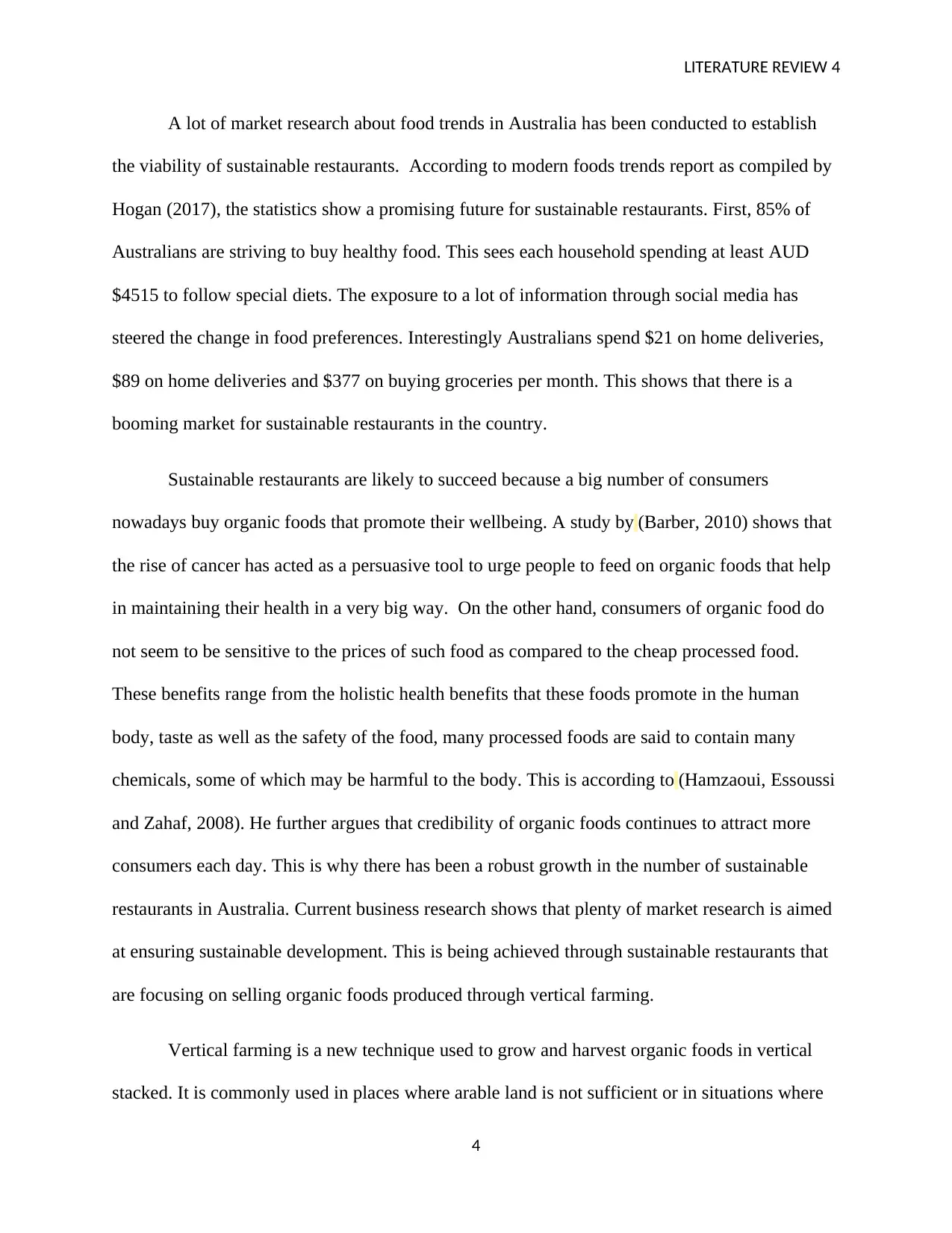
LITERATURE REVIEW 4
A lot of market research about food trends in Australia has been conducted to establish
the viability of sustainable restaurants. According to modern foods trends report as compiled by
Hogan (2017), the statistics show a promising future for sustainable restaurants. First, 85% of
Australians are striving to buy healthy food. This sees each household spending at least AUD
$4515 to follow special diets. The exposure to a lot of information through social media has
steered the change in food preferences. Interestingly Australians spend $21 on home deliveries,
$89 on home deliveries and $377 on buying groceries per month. This shows that there is a
booming market for sustainable restaurants in the country.
Sustainable restaurants are likely to succeed because a big number of consumers
nowadays buy organic foods that promote their wellbeing. A study by (Barber, 2010) shows that
the rise of cancer has acted as a persuasive tool to urge people to feed on organic foods that help
in maintaining their health in a very big way. On the other hand, consumers of organic food do
not seem to be sensitive to the prices of such food as compared to the cheap processed food.
These benefits range from the holistic health benefits that these foods promote in the human
body, taste as well as the safety of the food, many processed foods are said to contain many
chemicals, some of which may be harmful to the body. This is according to (Hamzaoui, Essoussi
and Zahaf, 2008). He further argues that credibility of organic foods continues to attract more
consumers each day. This is why there has been a robust growth in the number of sustainable
restaurants in Australia. Current business research shows that plenty of market research is aimed
at ensuring sustainable development. This is being achieved through sustainable restaurants that
are focusing on selling organic foods produced through vertical farming.
Vertical farming is a new technique used to grow and harvest organic foods in vertical
stacked. It is commonly used in places where arable land is not sufficient or in situations where
4
A lot of market research about food trends in Australia has been conducted to establish
the viability of sustainable restaurants. According to modern foods trends report as compiled by
Hogan (2017), the statistics show a promising future for sustainable restaurants. First, 85% of
Australians are striving to buy healthy food. This sees each household spending at least AUD
$4515 to follow special diets. The exposure to a lot of information through social media has
steered the change in food preferences. Interestingly Australians spend $21 on home deliveries,
$89 on home deliveries and $377 on buying groceries per month. This shows that there is a
booming market for sustainable restaurants in the country.
Sustainable restaurants are likely to succeed because a big number of consumers
nowadays buy organic foods that promote their wellbeing. A study by (Barber, 2010) shows that
the rise of cancer has acted as a persuasive tool to urge people to feed on organic foods that help
in maintaining their health in a very big way. On the other hand, consumers of organic food do
not seem to be sensitive to the prices of such food as compared to the cheap processed food.
These benefits range from the holistic health benefits that these foods promote in the human
body, taste as well as the safety of the food, many processed foods are said to contain many
chemicals, some of which may be harmful to the body. This is according to (Hamzaoui, Essoussi
and Zahaf, 2008). He further argues that credibility of organic foods continues to attract more
consumers each day. This is why there has been a robust growth in the number of sustainable
restaurants in Australia. Current business research shows that plenty of market research is aimed
at ensuring sustainable development. This is being achieved through sustainable restaurants that
are focusing on selling organic foods produced through vertical farming.
Vertical farming is a new technique used to grow and harvest organic foods in vertical
stacked. It is commonly used in places where arable land is not sufficient or in situations where
4
Paraphrase This Document
Need a fresh take? Get an instant paraphrase of this document with our AI Paraphraser
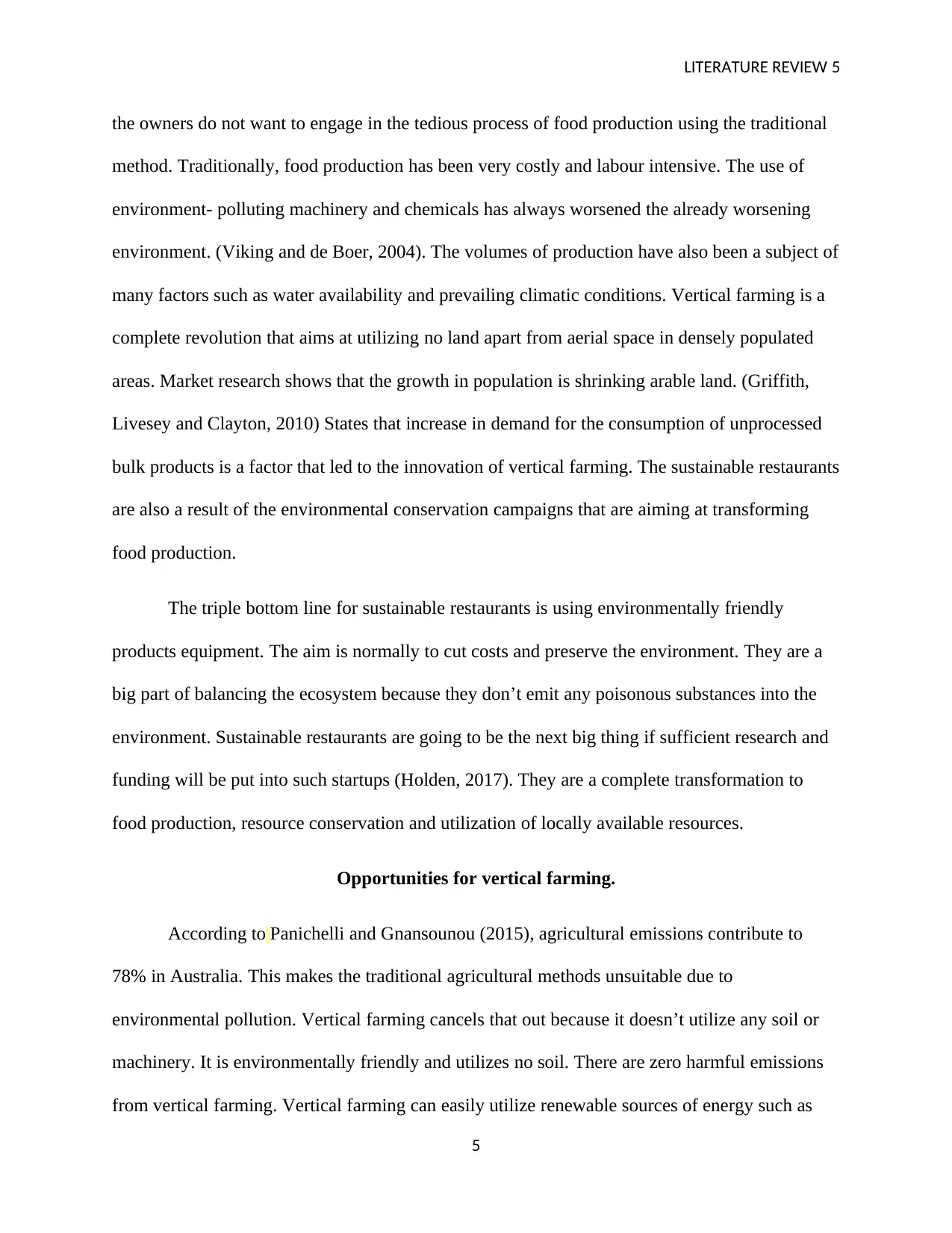
LITERATURE REVIEW 5
the owners do not want to engage in the tedious process of food production using the traditional
method. Traditionally, food production has been very costly and labour intensive. The use of
environment- polluting machinery and chemicals has always worsened the already worsening
environment. (Viking and de Boer, 2004). The volumes of production have also been a subject of
many factors such as water availability and prevailing climatic conditions. Vertical farming is a
complete revolution that aims at utilizing no land apart from aerial space in densely populated
areas. Market research shows that the growth in population is shrinking arable land. (Griffith,
Livesey and Clayton, 2010) States that increase in demand for the consumption of unprocessed
bulk products is a factor that led to the innovation of vertical farming. The sustainable restaurants
are also a result of the environmental conservation campaigns that are aiming at transforming
food production.
The triple bottom line for sustainable restaurants is using environmentally friendly
products equipment. The aim is normally to cut costs and preserve the environment. They are a
big part of balancing the ecosystem because they don’t emit any poisonous substances into the
environment. Sustainable restaurants are going to be the next big thing if sufficient research and
funding will be put into such startups (Holden, 2017). They are a complete transformation to
food production, resource conservation and utilization of locally available resources.
Opportunities for vertical farming.
According to Panichelli and Gnansounou (2015), agricultural emissions contribute to
78% in Australia. This makes the traditional agricultural methods unsuitable due to
environmental pollution. Vertical farming cancels that out because it doesn’t utilize any soil or
machinery. It is environmentally friendly and utilizes no soil. There are zero harmful emissions
from vertical farming. Vertical farming can easily utilize renewable sources of energy such as
5
the owners do not want to engage in the tedious process of food production using the traditional
method. Traditionally, food production has been very costly and labour intensive. The use of
environment- polluting machinery and chemicals has always worsened the already worsening
environment. (Viking and de Boer, 2004). The volumes of production have also been a subject of
many factors such as water availability and prevailing climatic conditions. Vertical farming is a
complete revolution that aims at utilizing no land apart from aerial space in densely populated
areas. Market research shows that the growth in population is shrinking arable land. (Griffith,
Livesey and Clayton, 2010) States that increase in demand for the consumption of unprocessed
bulk products is a factor that led to the innovation of vertical farming. The sustainable restaurants
are also a result of the environmental conservation campaigns that are aiming at transforming
food production.
The triple bottom line for sustainable restaurants is using environmentally friendly
products equipment. The aim is normally to cut costs and preserve the environment. They are a
big part of balancing the ecosystem because they don’t emit any poisonous substances into the
environment. Sustainable restaurants are going to be the next big thing if sufficient research and
funding will be put into such startups (Holden, 2017). They are a complete transformation to
food production, resource conservation and utilization of locally available resources.
Opportunities for vertical farming.
According to Panichelli and Gnansounou (2015), agricultural emissions contribute to
78% in Australia. This makes the traditional agricultural methods unsuitable due to
environmental pollution. Vertical farming cancels that out because it doesn’t utilize any soil or
machinery. It is environmentally friendly and utilizes no soil. There are zero harmful emissions
from vertical farming. Vertical farming can easily utilize renewable sources of energy such as
5
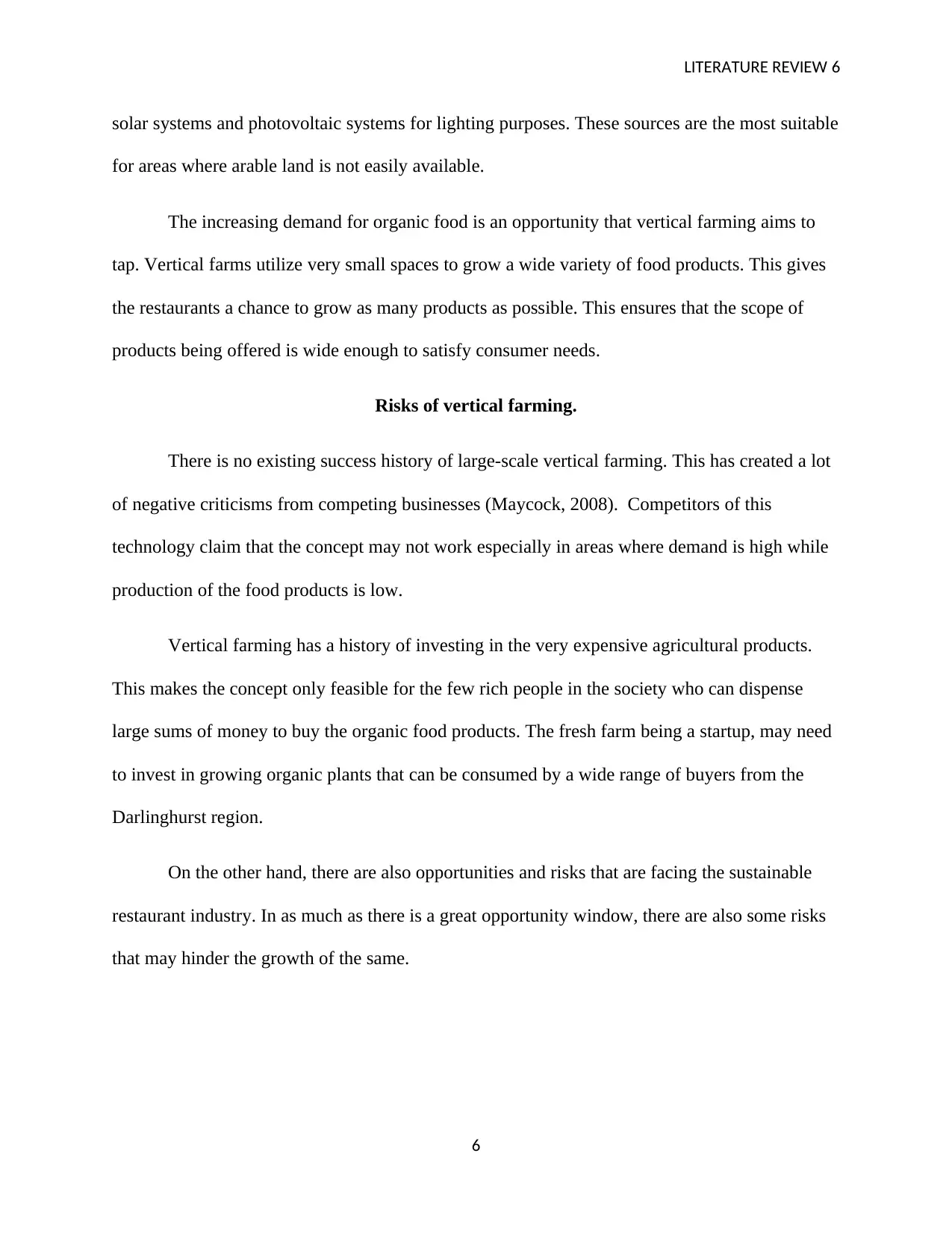
LITERATURE REVIEW 6
solar systems and photovoltaic systems for lighting purposes. These sources are the most suitable
for areas where arable land is not easily available.
The increasing demand for organic food is an opportunity that vertical farming aims to
tap. Vertical farms utilize very small spaces to grow a wide variety of food products. This gives
the restaurants a chance to grow as many products as possible. This ensures that the scope of
products being offered is wide enough to satisfy consumer needs.
Risks of vertical farming.
There is no existing success history of large-scale vertical farming. This has created a lot
of negative criticisms from competing businesses (Maycock, 2008). Competitors of this
technology claim that the concept may not work especially in areas where demand is high while
production of the food products is low.
Vertical farming has a history of investing in the very expensive agricultural products.
This makes the concept only feasible for the few rich people in the society who can dispense
large sums of money to buy the organic food products. The fresh farm being a startup, may need
to invest in growing organic plants that can be consumed by a wide range of buyers from the
Darlinghurst region.
On the other hand, there are also opportunities and risks that are facing the sustainable
restaurant industry. In as much as there is a great opportunity window, there are also some risks
that may hinder the growth of the same.
6
solar systems and photovoltaic systems for lighting purposes. These sources are the most suitable
for areas where arable land is not easily available.
The increasing demand for organic food is an opportunity that vertical farming aims to
tap. Vertical farms utilize very small spaces to grow a wide variety of food products. This gives
the restaurants a chance to grow as many products as possible. This ensures that the scope of
products being offered is wide enough to satisfy consumer needs.
Risks of vertical farming.
There is no existing success history of large-scale vertical farming. This has created a lot
of negative criticisms from competing businesses (Maycock, 2008). Competitors of this
technology claim that the concept may not work especially in areas where demand is high while
production of the food products is low.
Vertical farming has a history of investing in the very expensive agricultural products.
This makes the concept only feasible for the few rich people in the society who can dispense
large sums of money to buy the organic food products. The fresh farm being a startup, may need
to invest in growing organic plants that can be consumed by a wide range of buyers from the
Darlinghurst region.
On the other hand, there are also opportunities and risks that are facing the sustainable
restaurant industry. In as much as there is a great opportunity window, there are also some risks
that may hinder the growth of the same.
6
⊘ This is a preview!⊘
Do you want full access?
Subscribe today to unlock all pages.

Trusted by 1+ million students worldwide
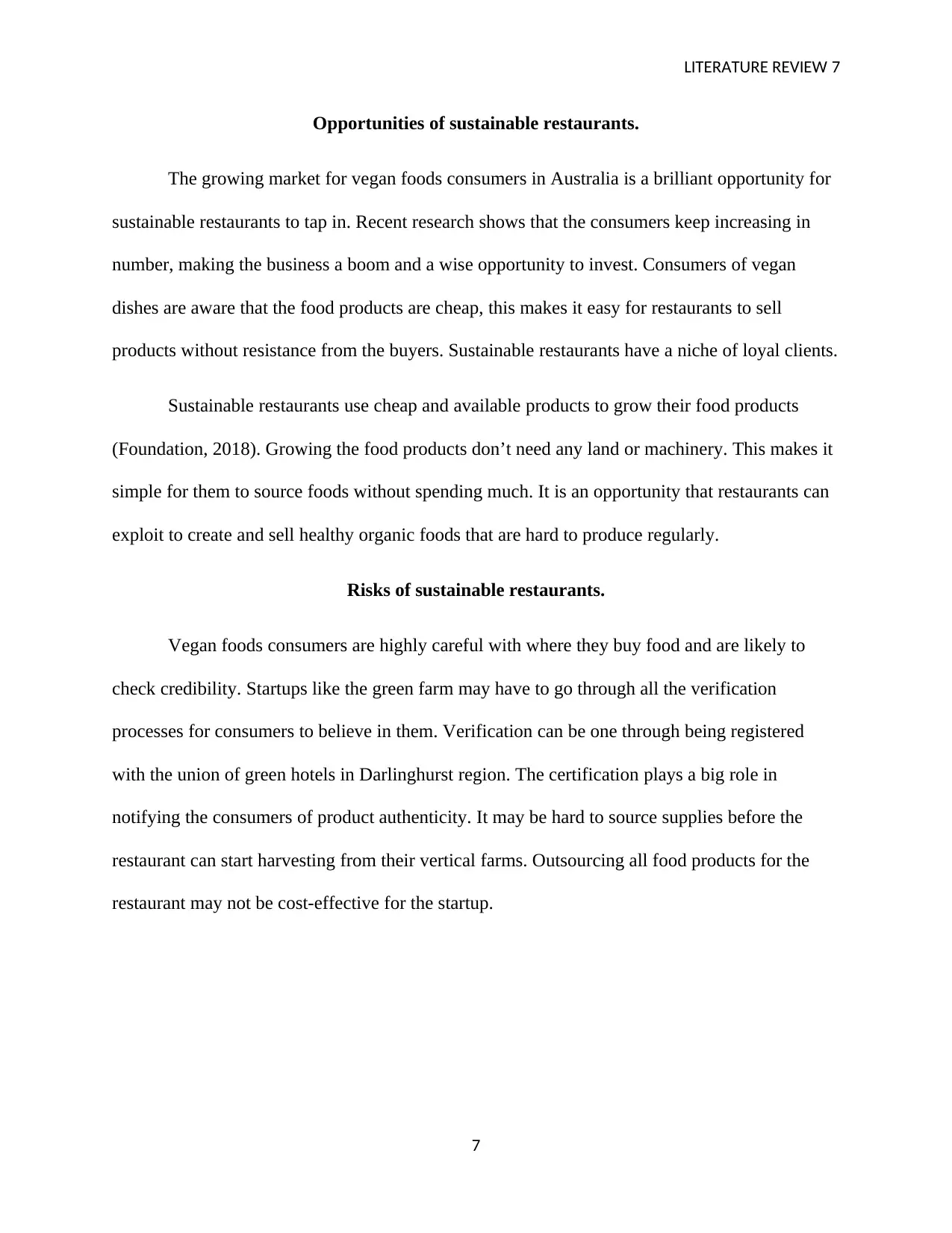
LITERATURE REVIEW 7
Opportunities of sustainable restaurants.
The growing market for vegan foods consumers in Australia is a brilliant opportunity for
sustainable restaurants to tap in. Recent research shows that the consumers keep increasing in
number, making the business a boom and a wise opportunity to invest. Consumers of vegan
dishes are aware that the food products are cheap, this makes it easy for restaurants to sell
products without resistance from the buyers. Sustainable restaurants have a niche of loyal clients.
Sustainable restaurants use cheap and available products to grow their food products
(Foundation, 2018). Growing the food products don’t need any land or machinery. This makes it
simple for them to source foods without spending much. It is an opportunity that restaurants can
exploit to create and sell healthy organic foods that are hard to produce regularly.
Risks of sustainable restaurants.
Vegan foods consumers are highly careful with where they buy food and are likely to
check credibility. Startups like the green farm may have to go through all the verification
processes for consumers to believe in them. Verification can be one through being registered
with the union of green hotels in Darlinghurst region. The certification plays a big role in
notifying the consumers of product authenticity. It may be hard to source supplies before the
restaurant can start harvesting from their vertical farms. Outsourcing all food products for the
restaurant may not be cost-effective for the startup.
7
Opportunities of sustainable restaurants.
The growing market for vegan foods consumers in Australia is a brilliant opportunity for
sustainable restaurants to tap in. Recent research shows that the consumers keep increasing in
number, making the business a boom and a wise opportunity to invest. Consumers of vegan
dishes are aware that the food products are cheap, this makes it easy for restaurants to sell
products without resistance from the buyers. Sustainable restaurants have a niche of loyal clients.
Sustainable restaurants use cheap and available products to grow their food products
(Foundation, 2018). Growing the food products don’t need any land or machinery. This makes it
simple for them to source foods without spending much. It is an opportunity that restaurants can
exploit to create and sell healthy organic foods that are hard to produce regularly.
Risks of sustainable restaurants.
Vegan foods consumers are highly careful with where they buy food and are likely to
check credibility. Startups like the green farm may have to go through all the verification
processes for consumers to believe in them. Verification can be one through being registered
with the union of green hotels in Darlinghurst region. The certification plays a big role in
notifying the consumers of product authenticity. It may be hard to source supplies before the
restaurant can start harvesting from their vertical farms. Outsourcing all food products for the
restaurant may not be cost-effective for the startup.
7
Paraphrase This Document
Need a fresh take? Get an instant paraphrase of this document with our AI Paraphraser
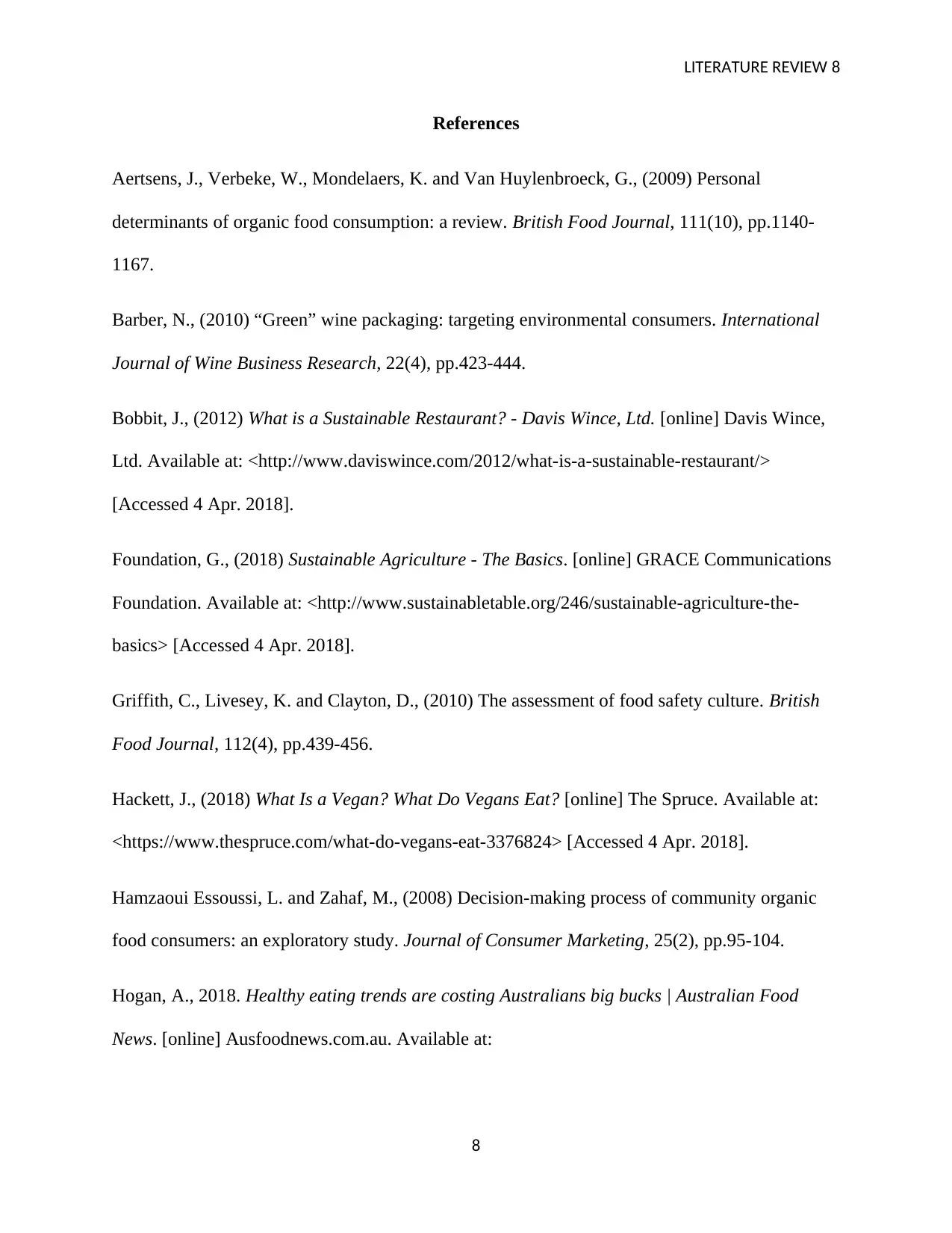
LITERATURE REVIEW 8
References
Aertsens, J., Verbeke, W., Mondelaers, K. and Van Huylenbroeck, G., (2009) Personal
determinants of organic food consumption: a review. British Food Journal, 111(10), pp.1140-
1167.
Barber, N., (2010) “Green” wine packaging: targeting environmental consumers. International
Journal of Wine Business Research, 22(4), pp.423-444.
Bobbit, J., (2012) What is a Sustainable Restaurant? - Davis Wince, Ltd. [online] Davis Wince,
Ltd. Available at: <http://www.daviswince.com/2012/what-is-a-sustainable-restaurant/>
[Accessed 4 Apr. 2018].
Foundation, G., (2018) Sustainable Agriculture - The Basics. [online] GRACE Communications
Foundation. Available at: <http://www.sustainabletable.org/246/sustainable-agriculture-the-
basics> [Accessed 4 Apr. 2018].
Griffith, C., Livesey, K. and Clayton, D., (2010) The assessment of food safety culture. British
Food Journal, 112(4), pp.439-456.
Hackett, J., (2018) What Is a Vegan? What Do Vegans Eat? [online] The Spruce. Available at:
<https://www.thespruce.com/what-do-vegans-eat-3376824> [Accessed 4 Apr. 2018].
Hamzaoui Essoussi, L. and Zahaf, M., (2008) Decision-making process of community organic
food consumers: an exploratory study. Journal of Consumer Marketing, 25(2), pp.95-104.
Hogan, A., 2018. Healthy eating trends are costing Australians big bucks | Australian Food
News. [online] Ausfoodnews.com.au. Available at:
8
References
Aertsens, J., Verbeke, W., Mondelaers, K. and Van Huylenbroeck, G., (2009) Personal
determinants of organic food consumption: a review. British Food Journal, 111(10), pp.1140-
1167.
Barber, N., (2010) “Green” wine packaging: targeting environmental consumers. International
Journal of Wine Business Research, 22(4), pp.423-444.
Bobbit, J., (2012) What is a Sustainable Restaurant? - Davis Wince, Ltd. [online] Davis Wince,
Ltd. Available at: <http://www.daviswince.com/2012/what-is-a-sustainable-restaurant/>
[Accessed 4 Apr. 2018].
Foundation, G., (2018) Sustainable Agriculture - The Basics. [online] GRACE Communications
Foundation. Available at: <http://www.sustainabletable.org/246/sustainable-agriculture-the-
basics> [Accessed 4 Apr. 2018].
Griffith, C., Livesey, K. and Clayton, D., (2010) The assessment of food safety culture. British
Food Journal, 112(4), pp.439-456.
Hackett, J., (2018) What Is a Vegan? What Do Vegans Eat? [online] The Spruce. Available at:
<https://www.thespruce.com/what-do-vegans-eat-3376824> [Accessed 4 Apr. 2018].
Hamzaoui Essoussi, L. and Zahaf, M., (2008) Decision-making process of community organic
food consumers: an exploratory study. Journal of Consumer Marketing, 25(2), pp.95-104.
Hogan, A., 2018. Healthy eating trends are costing Australians big bucks | Australian Food
News. [online] Ausfoodnews.com.au. Available at:
8
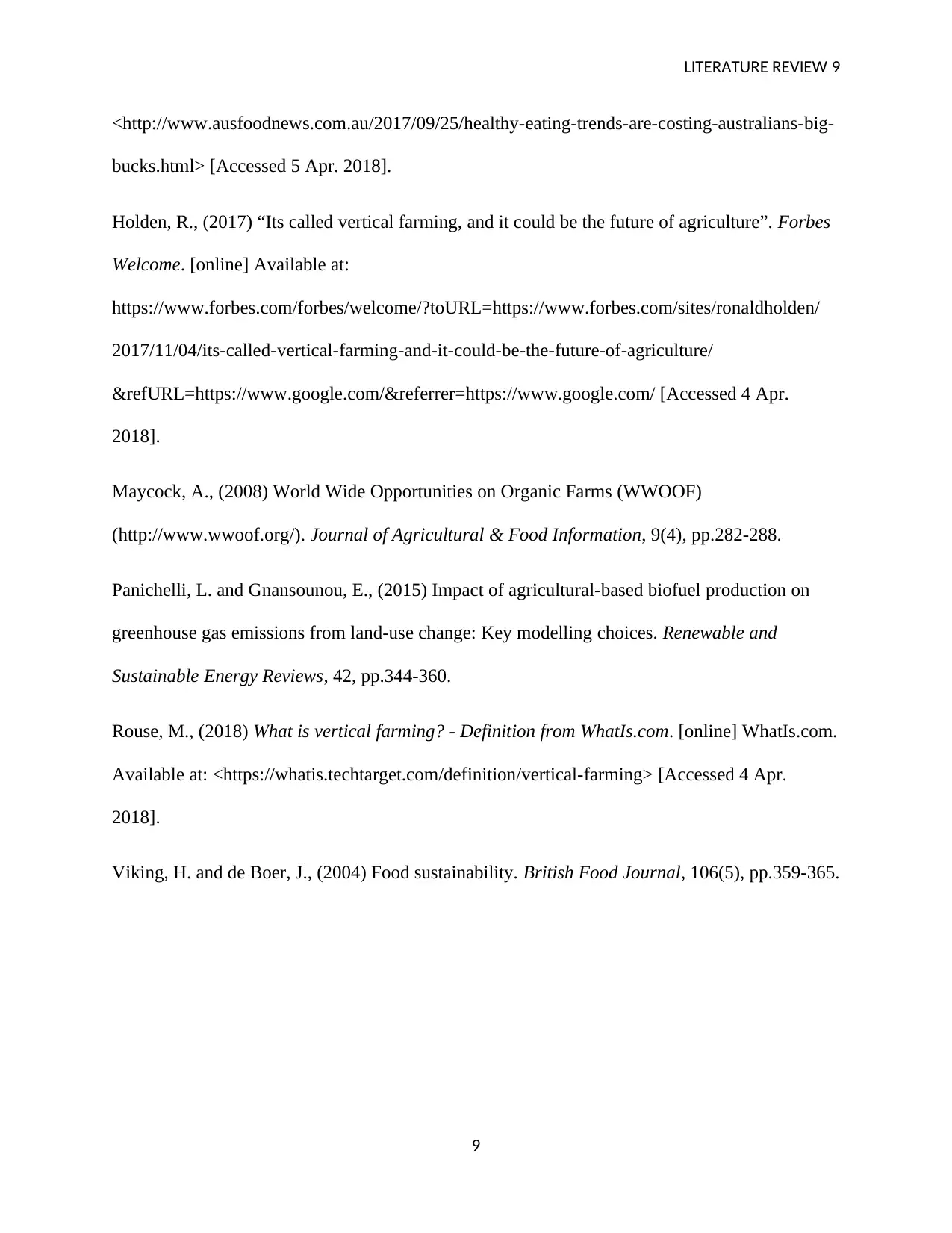
LITERATURE REVIEW 9
<http://www.ausfoodnews.com.au/2017/09/25/healthy-eating-trends-are-costing-australians-big-
bucks.html> [Accessed 5 Apr. 2018].
Holden, R., (2017) “Its called vertical farming, and it could be the future of agriculture”. Forbes
Welcome. [online] Available at:
https://www.forbes.com/forbes/welcome/?toURL=https://www.forbes.com/sites/ronaldholden/
2017/11/04/its-called-vertical-farming-and-it-could-be-the-future-of-agriculture/
&refURL=https://www.google.com/&referrer=https://www.google.com/ [Accessed 4 Apr.
2018].
Maycock, A., (2008) World Wide Opportunities on Organic Farms (WWOOF)
(http://www.wwoof.org/). Journal of Agricultural & Food Information, 9(4), pp.282-288.
Panichelli, L. and Gnansounou, E., (2015) Impact of agricultural-based biofuel production on
greenhouse gas emissions from land-use change: Key modelling choices. Renewable and
Sustainable Energy Reviews, 42, pp.344-360.
Rouse, M., (2018) What is vertical farming? - Definition from WhatIs.com. [online] WhatIs.com.
Available at: <https://whatis.techtarget.com/definition/vertical-farming> [Accessed 4 Apr.
2018].
Viking, H. and de Boer, J., (2004) Food sustainability. British Food Journal, 106(5), pp.359-365.
9
<http://www.ausfoodnews.com.au/2017/09/25/healthy-eating-trends-are-costing-australians-big-
bucks.html> [Accessed 5 Apr. 2018].
Holden, R., (2017) “Its called vertical farming, and it could be the future of agriculture”. Forbes
Welcome. [online] Available at:
https://www.forbes.com/forbes/welcome/?toURL=https://www.forbes.com/sites/ronaldholden/
2017/11/04/its-called-vertical-farming-and-it-could-be-the-future-of-agriculture/
&refURL=https://www.google.com/&referrer=https://www.google.com/ [Accessed 4 Apr.
2018].
Maycock, A., (2008) World Wide Opportunities on Organic Farms (WWOOF)
(http://www.wwoof.org/). Journal of Agricultural & Food Information, 9(4), pp.282-288.
Panichelli, L. and Gnansounou, E., (2015) Impact of agricultural-based biofuel production on
greenhouse gas emissions from land-use change: Key modelling choices. Renewable and
Sustainable Energy Reviews, 42, pp.344-360.
Rouse, M., (2018) What is vertical farming? - Definition from WhatIs.com. [online] WhatIs.com.
Available at: <https://whatis.techtarget.com/definition/vertical-farming> [Accessed 4 Apr.
2018].
Viking, H. and de Boer, J., (2004) Food sustainability. British Food Journal, 106(5), pp.359-365.
9
⊘ This is a preview!⊘
Do you want full access?
Subscribe today to unlock all pages.

Trusted by 1+ million students worldwide
1 out of 9
Related Documents
Your All-in-One AI-Powered Toolkit for Academic Success.
+13062052269
info@desklib.com
Available 24*7 on WhatsApp / Email
![[object Object]](/_next/static/media/star-bottom.7253800d.svg)
Unlock your academic potential
Copyright © 2020–2025 A2Z Services. All Rights Reserved. Developed and managed by ZUCOL.





